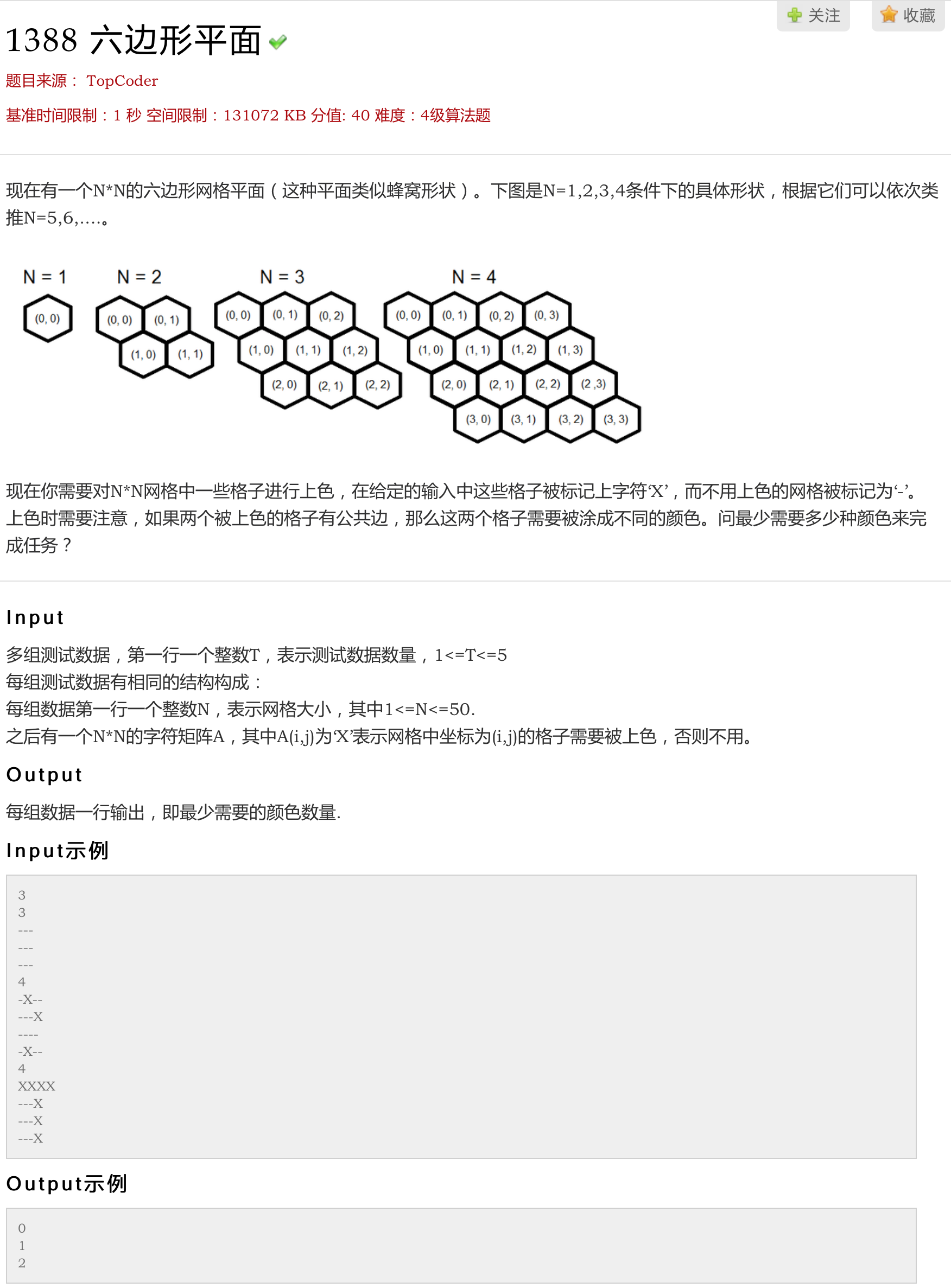描述
题解
这道题思路还是比较简单的,关键在于细节问题,不然就会像我一样一直被一个测试点卡死,粗心啦~~~算法是常规的dfs(我原本企图不用dfs,然而好麻烦)
首先,经过分析可以知道,颜色至多需要三种,0、1、2这三种结果不用过多分析,需要分析的是3这个答案的情况。
答案为3的情况分为两种,
第一:存在三个格子有公共顶点的情况;
第二:存在环,且环的长度为奇数。
这里存在一个隐藏的条件,当不存在第一种情况时,那么每个格子至多只能出现在一个环上,不信可以自己试试举反例,反正我没有举出来。
提供两份代码,一份比较笨,耗时比较高(One),第二份则十分之巧妙︿( ̄︶ ̄)︿
代码
One:
#include <iostream>
#include <cstdio>
#include <cstring>
using namespace std;
const int MAXN = 55;
const int DIR = 6;
char A[MAXN][MAXN];
bool B[MAXN][MAXN];
int N;
int res;
int dirX[] = {-1, -1, 0, 0, 1, 1};
int dirY[] = {0, 1, -1, 1, -1, 0};
void judge(int x, int y)
{
int key = 0;
if (A[x][y] == 'X')
{
key++;
}
if (y + 1 < N && A[x][y + 1] == 'X')
{
key++;
}
if (x + 1 < N && A[x + 1][y] == 'X')
{
key++;
}
else if (x - 1 >= 0 && y + 1 < N && A[x - 1][y + 1] == 'X')
{
key++;
}
if (key > res)
{
res = key;
}
return ;
}
void ring(int a, int b, int x, int y, int count)
{
for (int i = 0; i < DIR; i++)
{
if (x + dirX[i] >= 0 && x + dirX[i] < N && y + dirY[i] >= 0 && y + dirY[i] < N)
{
if (B[x + dirX[i]][y + dirY[i]])
{
if (a == x + dirX[i] && b == y + dirY[i] && count > 2)
{
if (count % 2)
{
res = 3;
return ;
}
}
continue;
}
if (A[x + dirX[i]][y + dirY[i]] == 'X')
{
B[x + dirX[i]][y + dirY[i]] = true;
ring(a, b, x + dirX[i], y + dirY[i], count + 1);
}
}
}
return ;
}
int main(int argc, const char * argv[])
{
// freopen("/Users/zyj/Desktop/input.txt", "r", stdin);
int T;
cin >> T;
while (T--)
{
cin >> N;
for (int i = 0; i < N; i++)
{
scanf("%s", A[i]);
}
res = 0;
for (int i = 0; i < N; i++)
{
for (int j = 0; j < N; j++)
{
judge(i, j);
if (res == 3)
{
break;
}
}
}
// 如果不存在三个粘连在一起的则判断环
if (res < 3)
{
for (int i = 0; i < N; i++)
{
for (int j = 0; j < N; j++)
{
if (A[i][j] == 'X')
{
memset(B, false, sizeof(B));
B[i][j] = true;
ring(i, j, i, j, 1);
}
}
}
}
cout << res << '\n';
}
return 0;
}Two:
#include <cstdio>
#include <cstring>
#include <iostream>
using namespace std;
const int MAXN = 55;
const int DIR = 6;
char ch[MAXN][MAXN];
int v[MAXN][MAXN];
int maxX, n;
bool connect, f;
int dir[6][2] = {{-1, 0}, {-1, 1}, {0, 1}, {1, 0}, {1, -1}, {0, -1}};
void countX(int l, int r)
{
int x, y, cnt = 1;
bool con = false;
int pre = -1;
for (int i = 0; i < DIR; i++)
{
x = l + dir[i][0], y = r + dir[i][1];
if (x >= 0 && x < n && y >= 0 && y < n)
{
if (ch[x][y] == 'X')
{
cnt++;
if (pre != -1)
{
con = true;
}
pre = i;
}
else
{
pre = -1;
}
}
else
{
pre = -1;
}
}
x = l + dir[0][0];
y = r + dir[0][1];
if (pre != -1 && x >= 0 && x < n && y >= 0 && y < n && ch[x][y] == 'X')
{
con = true;
}
if (con)
{
connect = con;
}
if (cnt > maxX)
{
maxX = cnt;
}
}
void dfs()
{
for (int i = 0; i < n; i++)
{
for (int j = 0; j < n; j++)
{
if (ch[i][j] == 'X')
{
countX(i, j);
}
}
}
return ;
}
void canFind(int sti, int stj, int tox, int toy, int step)
{
int x, y;
v[tox][toy] = step + 1;
if (f)
{
return ;
}
for (int i = 0; i < DIR; i++)
{
x = tox + dir[i][0], y = toy + dir[i][1];
if (x >= 0 && x < n && y >= 0 && y < n)
{
if (ch[x][y] == 'X')
{
if (v[x][y] == 0)
{
canFind(sti, stj, x, y, step + 1);
}
else if ((step + 1 - v[x][y]) % 2 == 0)
{
f = true;
return ;
}
}
}
}
return ;
}
void findOddCycle()
{
f = false;
memset(v, 0, sizeof(v));
for (int i = 0; i < n && !f; i++)
{
for (int j = 0; j < n && !f; j++)
{
if (ch[i][j] == 'X' && !v[i][j])
{
int x, y;
v[i][j] = 1;
for (int k = 0; k < DIR; k++)
{
x = i + dir[k][0];
y = j + dir[k][1];
if (x >= 0 && x < n && y >= 0 && y < n)
{
if (!v[x][y] && ch[x][y] == 'X')
{
canFind(i, j, x, y, 1);
}
}
}
}
}
}
return ;
}
int main()
{
int T;
scanf("%d", &T);
while (T--)
{
scanf("%d", &n);
for (int i = 0; i < n; i++)
{
cin >> ch[i];
}
maxX = 0;
connect = false;
dfs();
if (maxX < 3)
{
printf("%d\n", maxX);
}
else if (connect)
{
printf("3\n");
}
else
{
f = false;
findOddCycle();
if (f)
{
printf("3\n");
}
else
{
printf("2\n");
}
}
}
return 0;
}



























 被折叠的 条评论
为什么被折叠?
被折叠的 条评论
为什么被折叠?








